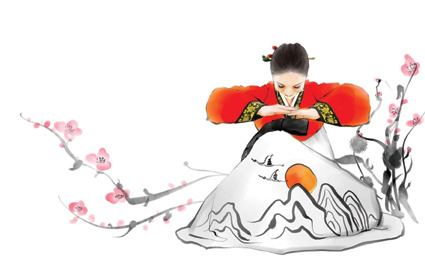Seollal (설날) is the Korean New Year that falls on the first day of the lunar calendar. As with many Asian cultures, the lunar new year is more important and more celebrated than the solar new year of January 1. It is a 3-day holiday that begins with the new year's day, during which families gather to spend time and celebrate together. Even the male members of a family that are serving their two-year compulsory military service may be granted special leave to see family during Seol.
The lead-up to Seollal will see people rushing to supermarkets and department stores alike to shop for gifts and various food packages to share with family. The first and third days of Seollal will have most of the main roads across the country congested with traffic; either people travelling to their hometown or back home. It is common to see the family gathering taking place at the house of the eldest male child of the family, at which the extended family will gather.
There are 3 main customs observed during Seollal. The first is the practice of eating ddeokguk (떡국) which is a plain soup with sliced pieces of rice cake as the main component. By having the ddeokguk, you turn a year older in Korea by the Korean age reckoning system.
The second custom is that of sebae (세배) which is where children perform a traditional bow to their elders in their family, wishing them a happy new year. Traditionally, it is common practice to wear Korean traditional clothes called hanbok during sebae, and adults will give 'new year's money' to the children upon completion of sebae.
The third custom is that of charye (차례) where family will travel to the burial place of grandparents to perform an ancient rite, paying respect to the dead. However today, especially with Korea's high Christian populace, charye will most commonly involve visiting the graves to simply pay respect or pray for the deceased as opposed to the tea rituals of days gone by.
The second custom is that of sebae (세배) which is where children perform a traditional bow to their elders in their family, wishing them a happy new year. Traditionally, it is common practice to wear Korean traditional clothes called hanbok during sebae, and adults will give 'new year's money' to the children upon completion of sebae.
The third custom is that of charye (차례) where family will travel to the burial place of grandparents to perform an ancient rite, paying respect to the dead. However today, especially with Korea's high Christian populace, charye will most commonly involve visiting the graves to simply pay respect or pray for the deceased as opposed to the tea rituals of days gone by.
Seollal is the biggest holiday on the Korean calendar; one that is celebrated with various festivities at folk villages, palaces, and even in metropolitan public spaces such as Gwanghamun Square in Seoul. Seol is a time of family, joy, and blessing.
-David
Sources:
http://mw2.google.com/mw-panoramio/photos/medium/80930749.jpg
http://d3q4n1mitqw7ms.cloudfront.net/luxetasy/wp-content/uploads/2010/02/cny_seollal_ddeokguk_itstonyhaha.jpg
http://25.media.tumblr.com/tumblr_lyahwgaige1qa8jdyo1_500
http://jetsettimes.files.wordpress.com/2012/09/p1040755.jpg
-David
Sources:
http://mw2.google.com/mw-panoramio/photos/medium/80930749.jpg
http://d3q4n1mitqw7ms.cloudfront.net/luxetasy/wp-content/uploads/2010/02/cny_seollal_ddeokguk_itstonyhaha.jpg
http://25.media.tumblr.com/tumblr_lyahwgaige1qa8jdyo1_500
http://jetsettimes.files.wordpress.com/2012/09/p1040755.jpg




No comments:
Post a Comment